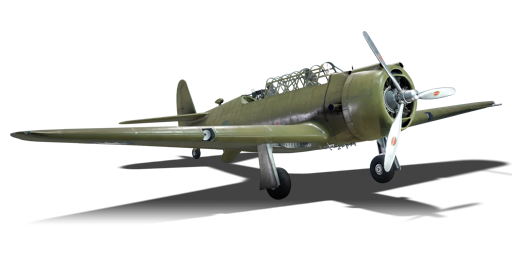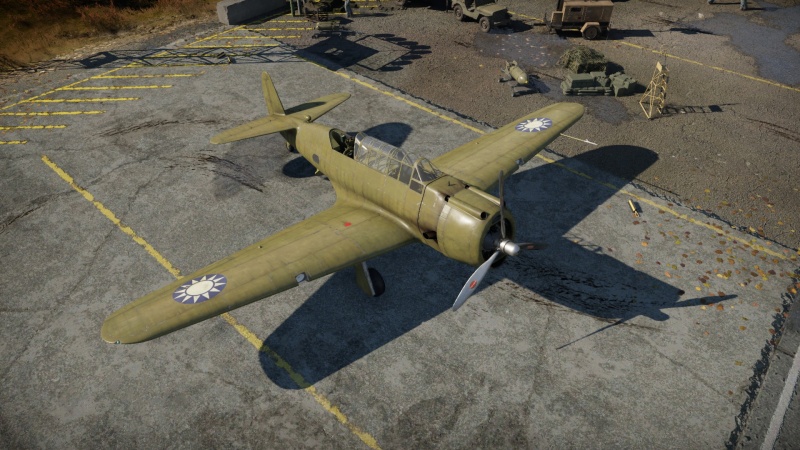Difference between revisions of "V-12D"
AnthonyIrwin (talk | contribs) (→General info) (Tag: Visual edit) |
Colok76286 (talk | contribs) (Edits) |
||
| Line 137: | Line 137: | ||
* 1 x 500 lb or 2 x 250 lb bombload is adequate against ground units | * 1 x 500 lb or 2 x 250 lb bombload is adequate against ground units | ||
| − | * 2 x nose-mounted 12. | + | * 2 x nose-mounted 12.7 mm MG is sufficient for self-defence against fighters such as [[Ki-43 (Family)|Ki-43]] |
* 2 x 250 lb bombs drop separately, allowing 2 passes though better aim is required | * 2 x 250 lb bombs drop separately, allowing 2 passes though better aim is required | ||
* Has ventral and dorsal turrets allowing it to fend off some attackers behind it | * Has ventral and dorsal turrets allowing it to fend off some attackers behind it | ||
* Turns decently with combat/takeoff flaps | * Turns decently with combat/takeoff flaps | ||
* Good over-the-nose view, beneficial in simulator battles | * Good over-the-nose view, beneficial in simulator battles | ||
| − | * | + | * Powerful engine |
'''Cons:''' | '''Cons:''' | ||
Revision as of 07:31, 23 June 2023
Contents
Description
The V-12D is a rank I Chinese strike aircraft with a battle rating of 2.0 (AB) and 2.3 (RB/SB). It was introduced in Update "Ground Breaking".
General info
Flight performance
Despite its large size, the V-12D is decent at turning although it is outshone by the many biplanes it faces. The acceleration and climb of this aircraft is poor, and is usually an easy prey for any interested fighter. The new engine with nearly twice as much engine power as the preceding V-11 will make the V-12D handle much better in flight, translating to improved flight characteristics and better odds if forced as an emergency fighter With the use of landing flaps, the plane can enter speeds as low as 120 km/h without stalling, which can be used to stall-trap potential enemies.
| Characteristics | Max Speed (km/h at 4,900 m) |
Max altitude (metres) |
Turn time (seconds) |
Rate of climb (metres/second) |
Take-off run (metres) | |||
|---|---|---|---|---|---|---|---|---|
| AB | RB | AB | RB | AB | RB | |||
| Stock | 453 | 440 | 8000 | 22.8 | 23.6 | 7.7 | 7.7 | 300 |
| Upgraded | 510 | 479 | 21.2 | 22.0 | 14.0 | 10.5 | ||
Details
| Features | ||||
|---|---|---|---|---|
| Combat flaps | Take-off flaps | Landing flaps | Air brakes | Arrestor gear |
| ✓ | ✓ | ✓ | X | X |
| Limits | ||||||
|---|---|---|---|---|---|---|
| Wings (km/h) | Gear (km/h) | Flaps (km/h) | Max Static G | |||
| Combat | Take-off | Landing | + | - | ||
| 680 | 320 | 330 | 280 | 280 | ~8 | ~4 |
| Optimal velocities (km/h) | |||
|---|---|---|---|
| Ailerons | Rudder | Elevators | Radiator |
| < 320 | < 260 | < 500 | > 250 |
Survivability and armour
Due to the design of V-12D is still the same as its predecessor V-11 (which was a single engine airliner), the aircraft has no extra protection against anything, meaning that V-12D should avoid heated battlefield or area covered by SPAAGs. But one good news is that the fuel tanks are all self-sealing tanks so it might potentially save your day from burning into a pile of scrap.
Modifications and economy
Armaments
Offensive armament
The V-12D is armed with:
- 2 x 12.7 mm M2 Browning machine guns, nose-mounted (600 rpg = 1,200 total)
Suspended armament
The V-12D can be outfitted with the following ordnance:
- Without load
- 2 x 250 lb AN-M57 bombs (500 lb total)
- 1 x 500 lb AN-M64A1 bomb (500 lb total)
Defensive armament
The V-12D is defended by:
- 1 x 7.62 mm Browning machine gun, dorsal turret (500 rpg)
- 1 x 7.62 mm Browning machine gun, ventral turret (500 rpg)
Usage in battles
V-12D is a significant upgrade over the previous V-11, sharing a very similar flight performance. The new engine, with nearly twice the engine output as the V-11, gives the V-12D better general flight characteristics (climb, acceleration, cruising speed, etc). It is labelled as an attacker (strike aircraft) as well so it will have an air respawn. For most of the time, avoid dogfights and keep away from SPAAGs to maximize the odds of survival. For self-defense, the dead-angle under the belly is now covered by another .30 M1919 machine gun. But in dire, its average turn rate is still sufficient to do last-ditch dogfights against heavy interceptors. One small yet significant change is the replacement of the quad .30 cal MGs with a pair of nose-mounted .50 cal MGs, which have the option to load the highly potent M8 API round, making air-to-air combat a more viable last-ditch option as they will set anything important on fire with enough well-placed shots
The only two option of loadouts are single 500 pound AN-M64 bomb or a pair of 250 pound AN-M63 bombs, allowing a choice between a higher yield "one-hit knock-out" bomb or the availability of a "fail-safe" second bomb. Although the bomb payload seems insufficient and requires precise hits over the target to score a kill, they are still viable to bomb interwar or early WWII tanks with relatively ease.
Manual Engine Control
| MEC elements | ||||||
|---|---|---|---|---|---|---|
| Mixer | Pitch | Radiator | Supercharger | Turbocharger | ||
| Oil | Water | Type | ||||
| Controllable | Controllable Not auto controlled |
Controllable Not auto controlled |
Controllable Not auto controlled |
Separate | Not controllable 2 gears |
Not controllable |
Pros and cons
Pros:
- 1 x 500 lb or 2 x 250 lb bombload is adequate against ground units
- 2 x nose-mounted 12.7 mm MG is sufficient for self-defence against fighters such as Ki-43
- 2 x 250 lb bombs drop separately, allowing 2 passes though better aim is required
- Has ventral and dorsal turrets allowing it to fend off some attackers behind it
- Turns decently with combat/takeoff flaps
- Good over-the-nose view, beneficial in simulator battles
- Powerful engine
Cons:
- Bombload is quite lacklustre for a ground attacker
- Low speed, will easily get caught by fighters like Bf 109 F, Ki-44, YaK-1
- Slow roll rate
- Turrets with 7.62 mm guns are not potent enough to damage robust targets like Ju 87, Bf 110
- Rather poor survivability when tailed
History
After the first order of 30 V-11 (two-seaters) by the Republic of China Government during the 2nd Sino-Japanese War, a further order of 26 V-12C (three-seaters with Wright R-1820-G105B piston engine) was placed in 1939; later yet another order for 52 V-12D (with Wright R-2600 engines) were placed.
Due to the lack of information from both American and Chinese sources, it was only estimated that 3 to 4 of those V-12Ds were assembled by the Chinese and the remaining records shown that they have already shipped parts for assembly in China; the first assembled aircraft was built in Leiyun, Yunnan (雲南雷允, in today's Ruili 瑞丽, Yunnan). After the CAMCO retreated from their home airfield Hangzhou Jianqiao Airfield, some parts of the remaining aircrafts were then transferred to Bangalore in India for further assembly by the Hindustan Aeronautics Limited.
Due to the capture of Yunnan by Japanese forces, the remaining parts that weren't able to transfer or assemble were lost in history and no further records could show the fate of those parts and aircrafts.
Media
- Skins
See also
Links to the articles on the War Thunder Wiki that you think will be useful for the reader, for example:
- reference to the series of the aircraft;
- links to approximate analogues of other nations and research trees.
External links
| Vultee Aircraft Corporation | |
|---|---|
| Export | P-66 · ▄A-35B · V-11 · V-12D |
| China twin-engine fighters and strike aircraft | |
|---|---|
| Twin-engine fighters | ␗Ki-45 hei/tei · ␗P-38L-1 |
| Strike aircraft | V-11 · V-12D · ␗IL-10 (1946) · Mosquito FB.Mk.26 |





